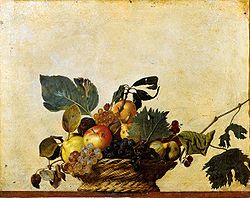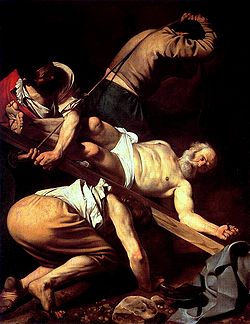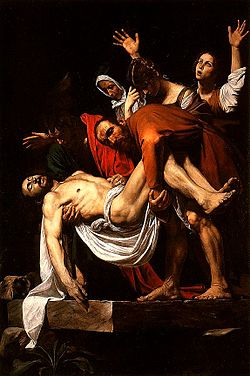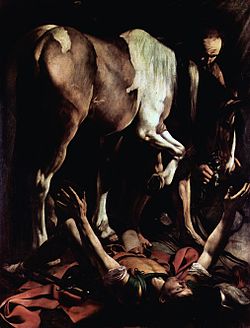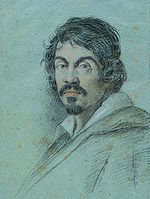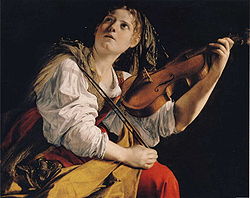- Caravaggio
-
For other uses, see Caravaggio (disambiguation).
Caravaggio 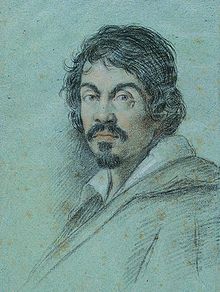
Chalk portrait of Caravaggio by Ottavio Leoni, c. 1621.Birth name Michelangelo Merisi Born 29 September 1571
Milan, LombardyDied 18 July 1610 (aged 38)
Porto Ercole, TuscanyNationality Italian Field Painting Movement Baroque Works see works by Caravaggio Michelangelo Merisi da Caravaggio (Italian pronunciation: [kara'vaddʒo]; 29 September 1571 – 18 July 1610) was an Italian artist active in Rome, Naples, Malta, and Sicily between 1593 and 1610. His paintings, which combine a realistic observation of the human state, both physical and emotional, with a dramatic use of lighting, had a formative influence on the Baroque school of painting.[1]
Caravaggio trained as a painter in Milan under a master who had himself trained under Titian. In his early twenties Caravaggio moved to Rome where, during the late 16th and early 17th centuries, many huge new churches and palazzi were being built and paintings were needed to fill them. During the Counter-Reformation the Roman Catholic Church searched for religious art with which to counter the threat of Protestantism, and for this task the artificial conventions of Mannerism, which had ruled art for almost a century, no longer seemed adequate. Caravaggio's novelty was a radical naturalism that combined close physical observation with a dramatic, even theatrical, use of chiaroscuro. This came to be known as Tenebrism, the shift from light to dark with little intermediate value. He burst upon the Rome art scene in 1600 with the success of his first public commissions, the Martyrdom of Saint Matthew and Calling of Saint Matthew. Thereafter he never lacked commissions or patrons, yet he handled his success atrociously. He was jailed on several occasions, vandalized his own apartment, and ultimately had a death warrant issued for him by the Pope.[2] An early published notice on him, dating from 1604 and describing his lifestyle three years previously, tells how "after a fortnight's work he will swagger about for a month or two with a sword at his side and a servant following him, from one ball-court to the next, ever ready to engage in a fight or an argument, so that it is most awkward to get along with him."[3] In 1606 he killed a young man in a brawl and fled from Rome with a price on his head. He was involved in a brawl in Malta in 1608, and another in Naples in 1609, possibly a deliberate attempt on his life by unidentified enemies. This encounter left him severely injured. A year later, at the age of 38, he died of a fever in Porto Ercole, near Grosseto in Tuscany, while on his way to Rome to receive a pardon.
Infamous while he lived, Caravaggio was forgotten almost immediately after his death, and it was only in the 20th century that his importance to the development of Western art was rediscovered. Despite this, his influence on the new Baroque style that eventually emerged from the ruins of Mannerism was profound. It can be seen directly or indirectly in the work of Rubens, Jusepe de Ribera, Bernini, and Rembrandt, and artists in the following generation heavily under his influence were called the "Caravaggisti" or "Caravagesques", as well as Tenebrists or "Tenebrosi" ("shadowists"). Andre Berne-Joffroy, Paul Valéry's secretary, said of him: "What begins in the work of Caravaggio is, quite simply, modern painting."[4]
Contents
Biography
 Boy with a Basket of Fruit, 1593–1594. Oil on canvas, 67 × 53 cm (26 in × 21 in). Galleria Borghese, Rome.
Boy with a Basket of Fruit, 1593–1594. Oil on canvas, 67 × 53 cm (26 in × 21 in). Galleria Borghese, Rome.
Early life (1571–1592)
Caravaggio was born in Milan,[5] where his father, Fermo Merisi, was a household administrator and architect-decorator to the Marchese of Caravaggio, a town not far from the city of Bergamo. His mother, Lucia Aratori, came from a propertied family of the same district. In 1576 the family moved to Caravaggio to escape a plague which ravaged Milan, and Caravaggio's father died there in 1577. It is assumed that the artist grew up in Caravaggio, but his family kept up connections with the Sforzas and with the powerful Colonna family, who were allied by marriage with the Sforzas and destined to play a major role later in Caravaggio's life.
Caravaggio's mother died in 1584, the same year he began his four year apprenticeship to the Milanese painter Simone Peterzano, described in the contract of apprenticeship as a pupil of Titian. Caravaggio appears to have stayed in the Milan-Caravaggio area after his apprenticeship ended, but it is possible that he visited Venice and saw the works of Giorgione, whom Federico Zuccari later accused him of imitating,[6] and Titian. He would also have become familiar with the art treasures of Milan, including Leonardo da Vinci's Last Supper, and with the regional Lombard art, a style which valued simplicity and attention to naturalistic detail and was closer to the naturalism of Germany than to the stylised formality and grandeur of Roman Mannerism.[7]
Rome (1592–1600)
Caravaggio left Milan for Rome in mid-1592, in flight after "certain quarrels" and the wounding of a police officer. He arrived in Rome "naked and extremely needy ... without fixed address and without provision ... short of money."[8] A few months later he was performing hack-work for the highly successful Giuseppe Cesari, Pope Clement VIII's favourite artist, "painting flowers and fruit"[9] in his factory-like workshop. Known works from this period include a small Boy Peeling a Fruit (his earliest known painting), a Boy with a Basket of Fruit, and the Young Sick Bacchus, supposedly a self-portrait done during convalescence from a serious illness that ended his employment with Cesari. All three demonstrate the physical particularity for which Caravaggio was to become renowned: the fruit-basket-boy's produce has been analysed by a professor of horticulture, who was able to identify individual cultivars right down to "... a large fig leaf with a prominent fungal scorch lesion resembling anthracnose (Glomerella cingulata)."[10]
Caravaggio left Cesari in January 1594, determined to make his own way. At this point he forged some extremely important friendships, with the painter Prospero Orsi, the architect Onorio Longhi, and the sixteen year old Sicilian artist Mario Minniti. Orsi, established in the profession, introduced him to influential collectors; Longhi, more balefully, introduced him to the world of Roman street-brawls; and Minniti served as a model and, years later, would be instrumental in helping Caravaggio to important commissions in Sicily.[11] The Fortune Teller, his first composition with more than one figure, shows Mario being cheated by a gypsy girl. The theme was quite new for Rome, and proved immensely influential over the next century and beyond. This, however, was in the future: at the time, Caravaggio sold it for practically nothing. The Cardsharps — showing another unsophisticated boy falling the victim of card cheats — is even more psychologically complex, and perhaps Caravaggio's first true masterpiece. Like the Fortune Teller it was immensely popular, and over 50 copies survive. More importantly, it attracted the patronage of Cardinal Francesco Maria Del Monte, one of the leading connoisseurs in Rome. For Del Monte and his wealthy art-loving circle Caravaggio executed a number of intimate chamber-pieces — The Musicians, The Lute Player, a tipsy Bacchus, an allegorical but realistic Boy Bitten by a Lizard — featuring Minniti and other adolescent models.
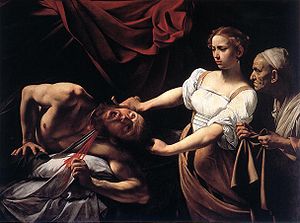 Judith Beheading Holofernes 1598–1599. Galleria Nazionale d'Arte Antica, Rome.
Judith Beheading Holofernes 1598–1599. Galleria Nazionale d'Arte Antica, Rome.
The realism returned with Caravaggio's first paintings on religious themes, and the emergence of remarkable spirituality. The first of these was the Penitent Magdalene, showing Mary Magdalene at the moment when she has turned from her life as a courtesan and sits weeping on the floor, her jewels scattered around her. "It seemed not a religious painting at all ... a girl sitting on a low wooden stool drying her hair ... Where was the repentance ... suffering ... promise of salvation?"[12] It was understated, in the Lombard manner, not histrionic in the Roman manner of the time. It was followed by others in the same style: Saint Catherine, Martha and Mary Magdalene, Judith Beheading Holofernes, a Sacrifice of Isaac, a Saint Francis of Assisi in Ecstasy, and a Rest on the Flight into Egypt. The works, while viewed by a comparatively limited circle, increased Caravaggio's fame with both connoisseurs and his fellow artists. But a true reputation would depend on public commissions, and for these it was necessary to look to the Church.
Already evident was the intense realism or naturalism for which Caravaggio is now famous. He preferred to paint his subjects as the eye sees them, with all their natural flaws and defects instead of as idealised creations. This allowed a full display of Caravaggio's virtuosic talents. This shift from accepted standard practice and the classical idealism of Michelangelo was very controversial at the time. Not only was his realism a noteworthy feature of his paintings during this period, he turned away from the lengthy preparations traditional in central Italy at the time. Instead, he preferred the Venetian practice of working in oils directly from the subject - half-length figures and still life. One of the characteristic paintings by Caravaggio at this time which gives a good demonstration of his virtuoso talent was his work, Supper at Emmaus from c.1600–1601.
 The Calling of Saint Matthew (1599–1600). Contarelli Chapel, San Luigi dei Francesi, Rome. The beam of light, which enters the picture from the direction of a real window, expresses in the blink of an eye the conversion of St Matthew, the hinge on which his destiny will turn, with no flying angels, parting clouds or other artifacts.
The Calling of Saint Matthew (1599–1600). Contarelli Chapel, San Luigi dei Francesi, Rome. The beam of light, which enters the picture from the direction of a real window, expresses in the blink of an eye the conversion of St Matthew, the hinge on which his destiny will turn, with no flying angels, parting clouds or other artifacts.
"Most famous painter in Rome" (1600–1606)
In 1599, presumably through the influence of Del Monte, Caravaggio was contracted to decorate the Contarelli Chapel in the church of San Luigi dei Francesi. The two works making up the commission, the Martyrdom of Saint Matthew and Calling of Saint Matthew, delivered in 1600, were an immediate sensation. Caravaggio's tenebrism (a heightened chiaroscuro) brought high drama to his subjects, while his acutely observed realism brought a new level of emotional intensity. Opinion among Caravaggio's artist peers was polarized. Some denounced him for various perceived failings, notably his insistence on painting from life, without drawings, but for the most part he was hailed as a great artistic visionary: "The painters then in Rome were greatly taken by this novelty, and the young ones particularly gathered around him, praised him as the unique imitator of nature, and looked on his work as miracles."[13]
Caravaggio went on to secure a string of prestigious commissions for religious works featuring violent struggles, grotesque decapitations, torture and death, most notable and most technically masterful among them The Taking of Christ of circa 1602 for the Mattei Family, recently rediscovered in Ireland after two centuries. For the most part each new painting increased his fame, but a few were rejected by the various bodies for whom they were intended, at least in their original forms, and had to be re-painted or find new buyers. The essence of the problem was that while Caravaggio's dramatic intensity was appreciated, his realism was seen by some as unacceptably vulgar.[14] His first version of Saint Matthew and the Angel, featured the saint as a bald peasant with dirty legs attended by a lightly clad over-familiar boy-angel, was rejected and a second version had to be painted as The Inspiration of Saint Matthew. Similarly, The Conversion of Saint Paul was rejected, and while another version of the same subject, the Conversion on the Way to Damascus, was accepted, it featured the saint's horse's haunches far more prominently than the saint himself, prompting this exchange between the artist and an exasperated official of Santa Maria del Popolo: "Why have you put a horse in the middle, and Saint Paul on the ground?" "Because!" "Is the horse God?" "No, but he stands in God's light!"[15]
Other works included Entombment, the Madonna di Loreto (Madonna of the Pilgrims), the Grooms' Madonna, and the Death of the Virgin. The history of these last two paintings illustrate the reception given to some of Caravaggio's art, and the times in which he lived. The Grooms' Madonna, also known as Madonna dei palafrenieri, painted for a small altar in Saint Peter's Basilica in Rome, remained there for just two days, and was then taken off. A cardinal's secretary wrote: "In this painting there are but vulgarity, sacrilege, impiousness and disgust...One would say it is a work made by a painter that can paint well, but of a dark spirit, and who has been for a lot of time far from God, from His adoration, and from any good thought..." The Death of the Virgin, then, commissioned in 1601 by a wealthy jurist for his private chapel in the new Carmelite church of Santa Maria della Scala, was rejected by the Carmelites in 1606. Caravaggio's contemporary Giulio Mancini records that it was rejected because Caravaggio had used a well-known prostitute as his model for the Virgin;[16] Giovanni Baglione, another contemporary, tells us it was due to Mary's bare legs[17] —a matter of decorum in either case. Caravaggio scholar John Gash suggests that the problem for the Carmelites may have been theological rather than aesthetic, in that Caravaggio's version fails to assert the doctrine of the Assumption of Mary, the idea that the Mother of God did not die in any ordinary sense but was assumed into Heaven. The replacement altarpiece commissioned (from one of Caravaggio's most able followers, Carlo Saraceni), showed the Virgin not dead, as Caravaggio had painted her, but seated and dying; and even this was rejected, and replaced with a work which showed the Virgin not dying, but ascending into Heaven with choirs of angels. In any case, the rejection did not mean that Caravaggio or his paintings were out of favour. The Death of the Virgin was no sooner taken out of the church than it was purchased by the Duke of Mantua, on the advice of Rubens, and later acquired by Charles I of England before entering the French royal collection in 1671.
 Amor Vincit Omnia. 1601–1602. Gemäldegalerie, Berlin. Caravaggio shows Cupid prevailing over all human endeavors: war, music, science, government.
Amor Vincit Omnia. 1601–1602. Gemäldegalerie, Berlin. Caravaggio shows Cupid prevailing over all human endeavors: war, music, science, government.
One secular piece from these years is Amor Victorious, painted in 1602 for Vincenzo Giustiniani, a member of Del Monte's circle. The model was named in a memoir of the early 17th century as "Cecco", the diminutive for Francesco. He is possibly Francesco Boneri, identified with an artist active in the period 1610–1625 and known as Cecco del Caravaggio ('Caravaggio's Cecco'),[18] carrying a bow and arrows and trampling symbols of the warlike and peaceful arts and sciences underfoot. He is unclothed, and it is difficult to accept this grinning urchin as the Roman god Cupid – as difficult as it was to accept Caravaggio's other semi-clad adolescents as the various angels he painted in his canvases, wearing much the same stage-prop wings. The point, however, is the intense yet ambiguous reality of the work: it is simultaneously Cupid and Cecco, as Caravaggio's Virgins were simultaneously the Mother of Christ and the Roman courtesans who modeled for them.
Exile and death (1606–1610)
Caravaggio led a tumultuous life. He was notorious for brawling, even in a time and place when such behavior was commonplace, and the transcripts of his police records and trial proceedings fill several pages. On 29 May 1606, he killed, possibly unintentionally, a young man named Ranuccio Tomassoni from Terni (Umbria).[19] Previously his high-placed patrons had protected him from the consequences of his escapades, but this time they could do nothing. Caravaggio, outlawed, fled to Naples. There, outside the jurisdiction of the Roman authorities and protected by the Colonna family, the most famous painter in Rome became the most famous in Naples. His connections with the Colonnas led to a stream of important church commissions, including the Madonna of the Rosary, and The Seven Works of Mercy.[20]
Despite his success in Naples, after only a few months in the city Caravaggio left for Malta, the headquarters of the Knights of Malta, presumably hoping that the patronage of Alof de Wignacourt, Grand Master of the Knights, could help him secure a pardon for Tomassoni's death. De Wignacourt proved so impressed at having the famous artist as official painter to the Order that he inducted him as a knight, and the early biographer Bellori records that the artist was well pleased with his success. Major works from his Malta period include a huge Beheading of Saint John the Baptist (the only painting to which he put his signature) and a Portrait of Alof de Wignacourt and his Page, as well as portraits of other leading knights. Yet by late August 1608 he was arrested and imprisoned. The circumstances surrounding this abrupt change of fortune have long been a matter of speculation, but recent investigation has revealed it to have been the result of yet another brawl, during which the door of a house was battered down and a knight seriously wounded.[21] He was imprisoned by the knights and managed to escape. By December he had been expelled from the Order "as a foul and rotten member."[22]
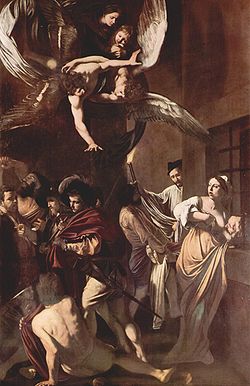 The Seven Works of Mercy, 1606–1607, Pio Monte della Misericordia, Naples.
The Seven Works of Mercy, 1606–1607, Pio Monte della Misericordia, Naples.
Caravaggio made his way to Sicily where he met his old friend Mario Minniti, who was now married and living in Syracuse. Together they set off on what amounted to a triumphal tour from Syracuse to Messina and on to the island capital, Palermo. In each city Caravaggio continued to win prestigious and well-paid commissions. Among other works from this period are Burial of St. Lucy, The Raising of Lazarus, and Adoration of the Shepherds. His style continued to evolve, showing now friezes of figures isolated against vast empty backgrounds. "His great Sicilian altarpieces isolate their shadowy, pitifully poor figures in vast areas of darkness; they suggest the desperate fears and frailty of man, and at the same time convey, with a new yet desolate tenderness, the beauty of humility and of the meek, who shall inherit the earth."[23] Contemporary reports depict a man whose behaviour was becoming increasingly bizarre, sleeping fully armed and in his clothes, ripping up a painting at a slight word of criticism, mocking the local painters.[24]
After only nine months in Sicily, Caravaggio returned to Naples. According to his earliest biographer he was being pursued by enemies while in Sicily and felt it safest to place himself under the protection of the Colonnas until he could secure his pardon from the pope (now Paul V) and return to Rome.[25] In Naples he painted The Denial of Saint Peter, a final John the Baptist (Borghese), and his last picture, The Martyrdom of Saint Ursula. His style continued to evolve — Saint Ursula is caught in a moment of highest action and drama, as the arrow fired by the king of the Huns strikes her in the breast, unlike earlier paintings which had all the immobility of the posed models. The brushwork was much freer and more impressionistic. Had Caravaggio lived, something new would have come.
In Naples an attempt was made on his life, by persons unknown. At first it was reported in Rome that the "famous artist" Caravaggio was dead, but then it was learned that he was alive, but seriously disfigured in the face. He painted a Salome with the Head of John the Baptist (Madrid), showing his own head on a platter, and sent it to de Wignacourt as a plea for forgiveness. Perhaps at this time he painted also a David with the Head of Goliath, showing the young David with a strangely sorrowful expression gazing on the severed head of the giant, which is again Caravaggio's. This painting he may have sent to his patron the unscrupulous art-loving Cardinal Scipione Borghese, nephew of the pope, who had the power to grant or withhold pardons.[26]
In the summer of 1610 he took a boat northwards to receive the pardon, which seemed imminent thanks to his powerful Roman friends. With him were three last paintings, gifts for Cardinal Scipione.[27] What happened next is the subject of much confusion and conjecture. The bare facts are that on 28 July an anonymous avviso (private newsletter) from Rome to the ducal court of Urbino reported that Caravaggio was dead. Three days later another avviso said that he had died of fever on his way from Naples to Rome. A poet friend of the artist later gave 18 July as the date of death, and a recent researcher claims to have discovered a death notice showing that the artist died on that day of a fever in Porto Ercole, near Grosseto in Tuscany. Human remains found in a church in Porto Ercole in 2010 are believed to almost certainly belong to Caravaggio.[28] The findings come after a year-long investigation using DNA, carbon dating and other analyses.[29]
Caravaggio might have died of lead poisoning. Bones with high lead levels were recently found in a grave likely to be Caravaggio's.[30] Paints used at the time contained high amounts of lead salts. Caravaggio is known to have indulged in violent behavior, as caused by lead poisoning.
As an artist
 The Taking of Christ, 1602. National Gallery of Ireland, Dublin. Caravaggio's application of the chiaroscuro technique shows through on the faces and armour notwithstanding the lack of a visible shaft of light. The figure on the extreme right is a self portrait.
The Taking of Christ, 1602. National Gallery of Ireland, Dublin. Caravaggio's application of the chiaroscuro technique shows through on the faces and armour notwithstanding the lack of a visible shaft of light. The figure on the extreme right is a self portrait.
The birth of Baroque
Caravaggio "put the oscuro (shadows) into chiaroscuro."[31] Chiaroscuro was practiced long before he came on the scene, but it was Caravaggio who made the technique definitive, darkening the shadows and transfixing the subject in a blinding shaft of light. With this came the acute observation of physical and psychological reality which formed the ground both for his immense popularity and for his frequent problems with his religious commissions. He worked at great speed, from live models, scoring basic guides directly onto the canvas with the end of the brush handle; very few of Caravaggio's drawings appear to have survived, and it is likely that he preferred to work directly on the canvas. The approach was anathema to the skilled artists of his day, who decried his refusal to work from drawings and to idealise his figures. Yet the models were basic to his realism. Some have been identified, including Mario Minniti and Francesco Boneri, both fellow artists, Mario appearing as various figures in the early secular works, the young Francesco as a succession of angels, Baptists and Davids in the later canvasses. His female models include Fillide Melandroni, Anna Bianchini, and Maddalena Antognetti (the "Lena" mentioned in court documents of the "artichoke" case[32] as Caravaggio's concubine), all well-known prostitutes, who appear as female religious figures including the Virgin and various saints.[33] Caravaggio himself appears in several paintings, his final self-portrait being as the witness on the far right to the Martyrdom of Saint Ursula.[34]
Caravaggio had a noteworthy ability to express in one scene of unsurpassed vividness the passing of a crucial moment. The Supper at Emmaus depicts the recognition of Christ by his disciples: a moment before he is a fellow traveler, mourning the passing of the Messiah, as he never ceases to be to the inn-keeper's eyes, the second after, he is the Saviour. In The Calling of St Matthew, the hand of the Saint points to himself as if he were saying "who, me?", while his eyes, fixed upon the figure of Christ, have already said, "Yes, I will follow you". With The Resurrection of Lazarus, he goes a step further, giving us a glimpse of the actual physical process of resurrection. The body of Lazarus is still in the throes of rigor mortis, but his hand, facing and recognizing that of Christ, is alive. Other major Baroque artists would travel the same path, for example Bernini, fascinated with themes from Ovid's Metamorphoses.
The Caravaggisti
The installation of the St. Matthew paintings in the Contarelli Chapel had an immediate impact among the younger artists in Rome, and Caravaggism became the cutting edge for every ambitious young painter. The first Caravaggisti included Orazio Gentileschi and Giovanni Baglione. Baglione's Caravaggio phase was short-lived; Caravaggio later accused him of plagiarism and the two were involved in a long feud. Baglione went on to write the first biography of Caravaggio. In the next generation of Caravaggisti there were Carlo Saraceni, Bartolomeo Manfredi and Orazio Borgianni. Gentileschi, despite being considerably older, was the only one of these artists to live much beyond 1620, and ended up as court painter to Charles I of England. His daughter Artemisia Gentileschi was also close to Caravaggio, and one of the most gifted of the movement. Yet in Rome and in Italy it was not Caravaggio, but the influence of Annibale Carracci, blending elements from the High Renaissance and Lombard realism, which ultimately triumphed.
Caravaggio's brief stay in Naples produced a notable school of Neapolitan Caravaggisti, including Battistello Caracciolo and Carlo Sellitto. The Caravaggisti movement there ended with a terrible outbreak of plague in 1656, but the Spanish connection – Naples was a possession of Spain – was instrumental in forming the important Spanish branch of his influence.
A group of Catholic artists from Utrecht, the "Utrecht Caravaggisti", travelled to Rome as students in the first years of the 17th century and were profoundly influenced by the work of Caravaggio, as Bellori describes. On their return to the north this trend had a short-lived but influential flowering in the 1620s among painters like Hendrick ter Brugghen, Gerrit van Honthorst, Andries Both and Dirck van Baburen. In the following generation the effects of Caravaggio, although attenuated, are to be seen in the work of Rubens (who purchased one of his paintings for the Gonzaga of Mantua and painted a copy of the Entombment of Christ), Vermeer, Rembrandt, and Velázquez, the last of whom presumably saw his work during his various sojourns in Italy.
Death and rebirth of a reputation
Caravaggio's fame scarcely survived his death. His innovations inspired the Baroque, but the Baroque took the drama of his chiaroscuro without the psychological realism. While he directly influenced the style of the artists mentioned above, and, at a distance, the Frenchmen Georges de La Tour and Simon Vouet, and the Spaniard Giuseppe Ribera, within a few decades his works were being ascribed to less scandalous artists, or simply overlooked. The Baroque, to which he contributed so much, had evolved, and fashions had changed, but perhaps more pertinently Caravaggio never established a workshop as the Carracci's did, and thus had no school to spread his techniques. Nor did he ever set out his underlying philosophical approach to art, the psychological realism which can only be deduced from his surviving work. Thus his reputation was doubly vulnerable to the critical demolition-jobs,done by two of his earliest biographers, Giovanni Baglione, a rival painter with a personal vendetta, and the influential 17th century critic Giovan Bellori, who had not known him but was under the influence of the French Classicist Poussin, who had not known him either but hated his work.[35]
In the 1920s art critic Roberto Longhi brought Caravaggio's name once more to the foreground, and placed him in the European tradition: "Ribera, Vermeer, La Tour and Rembrandt could never have existed without him. And the art of Delacroix, Courbet and Manet would have been utterly different".[36] The influential Bernard Berenson agreed: "With the exception of Michelangelo, no other Italian painter exercised so great an influence."[37]
Oeuvre
Only about 80 paintings by Caravaggio survive, and lost works (or alleged lost works) are found from time to time. One, The Calling of Saints Peter and Andrew, was recently authenticated and restored; it had been in storage in Hampton Court, mislabeled as a copy. Richard Francis Burton writes of a "picture of St. Rosario (in the museum of the Grand Duke of Tuscany), showing a circle of thirty men turpiter ligati" which is not known to have survived. The rejected version of The Inspiration of Saint Matthew intended for the Contarelli Chapel in San Luigi dei Francesi in Rome was destroyed during the bombing of Dresden, though black and white photographs of the work exist. In June 2011 it was announced that a previously unknown Caravaggio painting of Saint Augustine dating to about 1600 had been discovered in a private collection in Britain. Called a "significant discovery", the painting had never been published and is thought to have been commissioned by Vincenzo Giustiniani, a patron of the painter in Rome.[38]
Epitaph
Caravaggio's epitaph was composed by his friend Marzio Milesi. It reads:
"Michelangelo Merisi, son of Fermo di Caravaggio - in painting not equal to a painter, but to Nature itself - died in Port' Ercole - betaking himself hither from Naples - returning to Rome - 15th calend of August - In the year of our Lord 1610 - He lived thirty-six years nine months and twenty days - Marzio Milesi, Jurisconsult - Dedicated this to a friend of extraordinary genius."[39]
Chronology of major works
Main article: Chronology of works by CaravaggioSee also Category: Caravaggio paintings.See also
Footnotes
- ^ Getty profile, including variant spellings of the artist's name.
- ^ Caravaggio's Rap Sheet Reveals Him to have been a Lawless, Sword-Obsessed Wildman, and a Terrible Renter ARTINFO.com
- ^ Floris Claes van Dijk, a contemporary of Caravaggio in Rome in 1601, quoted in John Gash, "Caravaggio", p.13. The quotation originates in Karel van Mander's Het Schilder-Boek of 1604, translated in full in Howard Hibbard, "Caravaggio". The first reference to Caravaggio in a contemporary document from Rome is the listing of his name, with that of Prospero Orsi as his partner, as an 'assistente' in a procession in October 1594 in honour of St. Luke (see H. Waga "Vita nota e ignota dei virtuosi al Pantheon" Rome 1992, Appendix I, pp.219 and 220ff). The earliest informative account of his life in the city is a court transcript dated 11 July 1597, when Caravaggio and Prospero Orsi were witnesses to a crime near San Luigi de' Francesi. (See "The earliest account of Caravaggio in Rome" Sandro Corradini and Maurizio Marini, The Burlington Magazine, pp.25-28).
- ^ Quoted in Gilles Lambert, "Caravaggio", p.8.
- ^ Confirmed by the finding of the baptism certificate from the Milanese parish of Santo Stefano in Brolo: Rai International Online. Traditionally it was believed that he was born in the Lombardy town of Caravaggio, hence his name.
- ^ Harris, p. 21.
- ^ Rosa Giorgi, "Caravaggio: Master of light and dark – his life in paintings", p.12.
- ^ Quoted without attribution in Robb, p.35, apparently based on the three primary sources, Mancini, Baglione and Bellori, all of whom depict Caravaggio's early Roman years as a period of extreme poverty (see references below).
- ^ Giovanni Pietro Bellori, Le Vite de' pittori, scultori, et architetti moderni, 1672: "Michele was forced by necessity to enter the services of Cavalier Giuseppe d'Arpino, by whom he was employed to paint flowers and fruits so realistically that they began to attain the higher beauty that we love so much today."
- ^ Caravaggio's Fruit: A Mirror on Baroque Horticulture (Jules Janick, Department of Horticulture and Landscape Architecture, Purdue University, West Lafayette, Indiana)
- ^ Catherine Puglisi, "Caravaggio", p.79. Longhi was with Caravaggio on the night of the fatal brawl with Tomassoni; Robb, "M", p.341, believes that Minniti was as well.
- ^ Robb, p.79. Robb is drawing on Bellori, who praises Caravaggio's "true" colours but finds the naturalism offensive: "He (Caravaggio) was satisfied with [the] invention of nature without further exercising his brain."
- ^ Bellori. The passage continues: "[The younger painters] outdid each other in copying him, undressing their models and raising their lights; and rather than setting out to learn from study and instruction, each readily found in the streets or squares of Rome both masters and models for copying nature."
- ^ For an outline of the Counter-Reformation Church's policy on decorum in art, see Giorgi, p.80. For a more detailed discussion, see Gash, p.8ff; and for a discussion of the part played by notions of decorum in the rejection of "St Matthew and the Angel" and "Death of the Virgin", see Puglisi, pp.179–188.
- ^ Quoted without attribution in Lambert, p.66.
- ^ Mancini: "Thus one can understand how badly some modern artists paint, such as those who, wishing to portray the Virgin Our Lady, depict some dirty prostitute from the Ortaccio, as Michelangelo da Caravaggio did in the Death of the Virgin in that painting for the Madonna della Scala, which for that very reason those good fathers rejected it, and perhaps that poor man suffered so much trouble in his lifetime."
- ^ Baglione: "For the [church of] Madonna della Scala in Trastevere he painted the death of the Madonna, but because he had portrayed the Madonna with little decorum, swollen and with bare legs, it was taken away, and the Duke of Mantua bought it and placed it in his most noble gallery."
- ^ While Gianni Papi's identification of Cecco del Caravaggio as Francesco Boneri is widely accepted, the evidence connecting Boneri to Caravaggio's servant and model in the early 17th century is circumstantial. See Robb, pp193–196.
- ^ The circumstances of the brawl and the death of Ranuccio Tomassoni remain mysterious. Several contemporary avvisi referred to a quarrel over a gambling debt and a tennis game, and this explanation has become established in the popular imagination. But recent scholarship has made it clear that more was involved. Good modern accounts are to be found in Peter Robb's "M" and Helen Langdon's "Caravaggio: A Life". An interesting theory relating the death to Renaissance notions of honour and symbolic wounding has been advanced by art historian Andrew Graham-Dixon. 'Red-blooded Caravaggio killed love rival in bungled castration attempt'
- ^ In 1606, following the death of Tomassoni, he fled first to the Colonna estates south of Rome, then on to Naples where Costanza Colonna Sforza, widow of Francesco Sforza, in whose husband's household Caravaggio's father had held a position, maintained a palace. Costanza's brother Ascanio was Cardinal-Protector of the Kingdom of Naples, another brother, Marzio, was an advisor to the Spanish Viceroy, and a sister was married into the important Neapolitan Carafa family—connections which might help explain the cornucopia of major commissions which fell into Caravaggio's lap in that city. Costanza's son Fabrizio Sforza Colonna, Knight of Malta and general of the Order's galleys, appears to have facilitated his arrival in the island in 1607 and his escape the next year, and he stayed in Costanza's Neapolitan palazzo on his return there in 1609. These connections are treated in most biographies and studies—see, for example, Catherine Puglisi, "Caravaggio", p.258, for a brief outline. Helen Langdon, "Caravaggio: A Life", ch.12 and 15, and Peter Robb, "M", pp.398ff and 459ff, give a fuller account.
- ^ The discovery of the evidence for this brawl was reported by Dr Keith Sciberras of the University of Malta, in "Frater Michael Angelus in tumultu: the cause of Caravaggio's imprisonment in Malta", The Burlington Magazine, CXLV, April 2002, pp.229–232, and "Riflessioni su Malta al tempo del Caravaggio", Paragone Arte, Anno LII N.629, July 2002, pp.3–20. Sciberras' findings are summarised online at Caravaggio.com.
- ^ This was the formal phrase used in all such cases. The senior knights of the Order convened on 1 December 1608 and, after verifying that the accused had failed to appear although summoned four times, voted unanimously to expel their putridum et foetidum ex-brother. Caravaggio was expelled, not for his crime, but for having left Malta without permission (i.e., escaping).
- ^ Langdon, p.365.
- ^ Caravaggio displayed bizarre behaviour from very early in his career. Mancini describes him as "extremely crazy", a letter of Del Monte notes his strangeness, and Mario Minniti's 1724 biographer says that Mario left Caravaggio because of his behaviour. The strangeness seems to have increased after Malta. Susinno's early 18th century Le vite de' pittori Messinesi, "Lives of the Painters of Messina", provides several colourful anecdotes of Caravaggio's erratic behaviour in Sicily, and these are reproduced in modern full-length biographies such as Langdon and Robb. Bellori writes of Caravaggio's "fear" driving him from city to city across the island and finally, "feeling that it was no longer safe to remain", to Naples. Baglione says Caravaggio was being "chased by his enemy", but like Bellori does not say who this enemy was.
- ^ Baglione says that Caravaggio in Naples had "given up all hope of revenge" against his unnamed enemy.
- ^ According to a 17th century writer the painting the head of Goliath is a self-portrait of the artist, while David is il suo Caravaggino, "his little Caravaggio". This phrase is obscure, but it has been interpreted as meaning either that the boy is a youthful self-portrait, or, more commonly, that this is the Cecco who modelled for the Amor Vincit. The sword-blade carries an abbreviated inscription which has been interpreted as meaning Humility Conquers Pride. Attributed to a date in Caravaggio's late Roman period by Bellori, the recent tendency is to see it as a product on Caravaggio's second Neapolitan period. (See Gash, p.125).
- ^ A letter from the Bishop of Caserta in Naples to Cardinal Scipione Borghese in Rome, dated 29 July 1610, informs the Cardinal that the Marchesa of Caravaggio is holding two John the Baptists and a Magdalene which were intended for Borghese. These were presumably the price of Caravaggio's pardon from Borghese's uncle, the pope.
- ^ Vatican reveals Caravaggio painting 'found' in Rome BBC website, published: 19 July 2010, accessed: 20 July 2010
- ^ Church bones 'belong to Caravaggio', researchers say BBC website, published: 16 June 2010, accessed: 20 July 2010
- ^ The mystery of Caravaggio's death solved at last – painting killed him, Tom Kington, The Guardian, Wednesday, 16 June 2010.
- ^ Lambert, p.11.
- ^ Much of the documentary evidence for Caravaggio's life in Rome comes from court records; the "artichoke" case refers to an occasion when the artist threw a dish of hot artichokes at a waiter.
- ^ Robb, passim, makes a fairly exhaustive attempt to identify models and relate them to individual canvases.
- ^ Caravaggio's self-portraits run from the Sick Bacchus at the beginning of his career to the head of Goliath in the David with the Head of Goliath in Rome's Borghese Gallery. Previous artists had included self-portraits as onlookers to the action, but Caravaggio's innovation was to include himself as a participant.
- ^ Also see criticism by fellow Italian Vincenzo Carducci (living in Spain), who calls Caravaggio an "Antichrist" of painting with "monstrous" talents of deception.
- ^ Roberto Longhi, quoted in Lambert, op. cit., p.15
- ^ Bernard Berenson, in Lambert, op. cit., p.8
- ^ Alberge, Dalya (19 June 2011). "Unknown Caravaggio painting unearthed in Britain". The Guardian. http://www.guardian.co.uk/artanddesign/2011/jun/19/unknown-caravaggio-painting-unearthed-britain. Retrieved 2011-06-20.
- ^ Inscriptiones et Elogia (Cod.Vat.7927)
References
- Primary sources
The main primary sources for Caravaggio's life are:
- Giulio Mancini's comments on Caravaggio in Considerazioni sulla pittura, c.1617-1621
- Giovanni Baglione's Le vite de' pittori, 1642
- Giovanni Pietro Bellori's Le Vite de' pittori, scultori et architetti moderni, 1672
All have been reprinted in Howard Hibbard's "Caravaggio" and in the appendices to Catherine Puglisi's "Caravaggio".
- Secondary sources
- Maurizio Calvesi, Caravaggio, Art Dossier 1986, Giunti Editori (1986) (ISBN not available)
- John Denison Champlin and Charles Callahan Perkins, Ed., Cyclopedia of Painters and Paintings, Charles Scribner's Sons, New York (1885), p. 241 (available at the Harvard's Fogg Museum Library and scanned on Google Books)
- Andrea Dusio, Caravaggio White Album, Cooper Arte, Roma 2009, ISBN 978-88-7394-128-6
- Walter Friedlaender, Caravaggio Studies, Princeton: Princeton University Press 1955
- John Gash, Caravaggio, Chaucer Press, (2004) ISBN 1904449220)
- Rosa Giorgi, Caravaggio: Master of light and dark - his life in paintings, Dorling Kindersley (1999) ISBN 978-0-7894-4138-6
- Andrew Graham-Dixon, Caravaggio: A Life Sacred and Profane, London, Allen Lane, 2009. ISBN 9780713996746
- Howard Hibbard, Caravaggio (1983) ISBN 978-0-06-433322-1
- Harris, Ann Sutherland. Seventeenth-century Art & Architecture, Laurence King Publishing (2004), ISBN 1856694151.
- Michael Kitson, The Complete Paintings of Caravaggio London, Abrams, 1967. New edition: Weidenfeld & Nicholson, 1969 and 1986, ISBN 978-0297761082
- Pietro Koch, Caravaggio - The Painter of Blood and Darkness, Gunther Edition, (Rome - 2004)
- Gilles Lambert, Caravaggio, Taschen, (2000) ISBN 978-3-8228-6305-3
- Helen Langdon, Caravaggio: A Life, Farrar, Straus and Giroux, 1999 (original UK edition 1998) ISBN 978-0-374-11894-5
- Alfred Moir, The Italian Followers of Caravaggio, Harvard University Press (1967) (ISBN not available)
- Catherine Puglisi, Caravaggio, Phaidon (1998) ISBN 978-0-7148-3966-0
- Peter Robb, M, Duffy & Snellgrove, 2003 amended edition (original edition 1998) ISBN 978-1-876631-79-6
- John Spike, with assistance from Michèle Kahn Spike, Caravaggio with Catalogue of Paintings on CD-ROM, Abbeville Press, New York (2001) ISBN 978-0-7892-0639-8
- John L. Varriano, Caravaggio: The Art of Realism, Pennsylvania State University Press (University Park, PA - 2006)
External links
Biography
Articles and essays
- FBI Art Theft Notice for Caravaggio's Nativity
- Interview with Peter Robb, author of M
- Compare Rembrandt with Caravaggio.
- Caravaggio and the Camera Obscura
- Caravaggio's incisions by Ramon van de Werken
- Caravaggio's use of the Camera Obscura: Lapucci
- Roberta Lapucci's website and most of her pubblications on Caravaggio as freely downloadable PDF
Art works
- www.caravaggio-foundation.org 175 works by Caravaggio
- Caravaggio, Michelangelo Merisi da Caravaggio WebMuseum, Paris webpage
- Caravaggio's EyeGate Gallery
Podcasts
Music
Michelangelo Merisi da Caravaggio · Artists in biographies by Giovanni Baglione · Baroque · Chiaroscuro · Tenebrism · Paintings attributed to CaravaggioDutch Caravaggisti Dirck van Baburen · Jan van Bijlert · Paulus Bor · Andries Both · Hendrick Bloemaert · Jan Gerritsz van Bronckhorst · Hendrick ter Brugghen · Wouter Crabeth II · Gerard van Honthorst · Matthias StomFlemish Caravaggisti French Caravaggisti Trophime Bigot · Valentin de Boulogne · Georges de La Tour · Jean LeClerc · Nicolas Tournier · Claude Vignon · Simon VouetItalian Caravaggisti Giovanni Baglione · Orazio Borgianni · Battistello Caracciolo · Cecco del Caravaggio · Bernardo Cavallino · Bartolomeo Cavarozzi · Domenico Fetti · Artemisia Gentileschi · Orazio Gentileschi · Ottavio Leoni · Bartolomeo Manfredi · Mario Minniti · Mattia Preti · Orazio Riminaldi · Carlo Saraceni · Bartolomeo Schedoni · Giovanni Serodine · Carlo Sellitto · Leonello Spada · Massimo Stanzione · Giuseppe VermiglioSpanish Caravaggisti Categories:- Caravaggisti
- Caravaggio
- 1571 births
- 1610 deaths
- People from Milan
- Italian Baroque painters
- Italian painters
- Roman Catholic Church painters
- Italian Roman Catholics
- Knights of Malta
Wikimedia Foundation. 2010.


